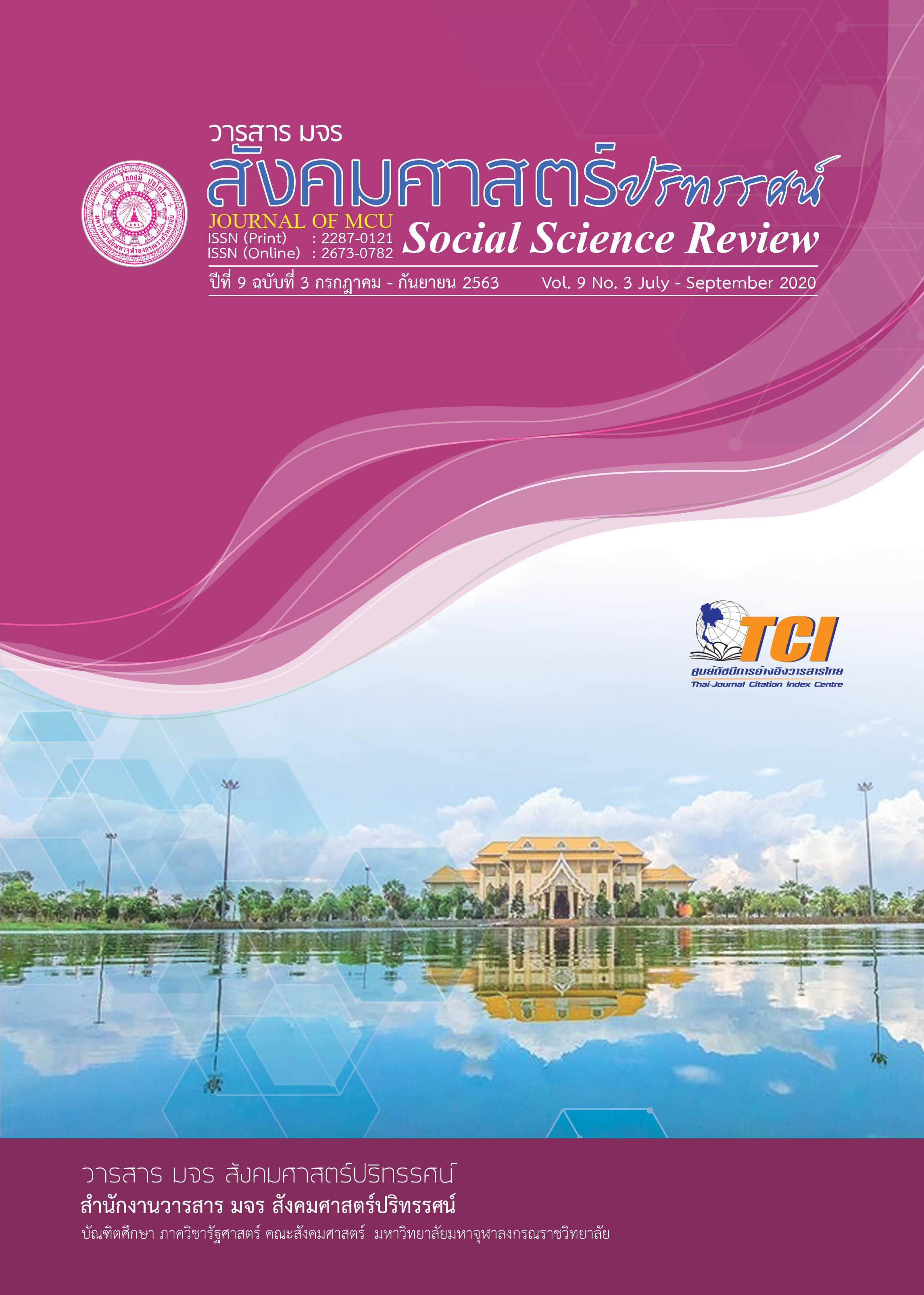โมเดลความสัมพันธ์เชิงสาเหตุการจัดการเทคโนโลยีดิจิทัลเพื่อความเป็นเลิศ และประสิทธิผลองค์การของมหาวิทยาลัยเอกชนในประเทศไทย
คำสำคัญ:
การจัดการเทคโนโลยีดิจิทัล, ความเป็นเลิศ, ประสิทธิผลองค์การบทคัดย่อ
บทความวิจัยนี้มีวัตถุประสงค์เพื่อศึกษาโมเดลความสัมพันธ์เชิงสาเหตุการจัดการเทคโนโลยีดิจิทัลเพื่อความเป็นเลิศ และประสิทธิผลองค์การของมหาวิทยาลัยเอกชนในประเทศไทย และตรวจสอบความสอดคล้องระหว่างรูปแบบสมมติฐานกับข้อมูลเชิงประจักษ์ในด้านการจัดการเทคโนโลยีดิจิทัลความเป็นเลิศ และประสิทธิผลองค์การของมหาวิทยาลัยเอกชนในประเทศไทย กลุ่มตัวอย่าง ได้แก่ ผู้บริหารมหาวิทยาลัยเอกชนที่เป็นสมาชิกสมาคมสถาบันอุดมศึกษาเอกชนแห่งประเทศไทย จำนวน 260 คน การวิเคราะห์ข้อมูลใช้รูปแบบความสัมพันธ์โครงสร้างเชิงเส้น (Structural Equation Modeling: SEM) เป็นสถิติประเภทตัวแปรพหุ (Multivariate Statistics) ที่บูรณาการเทคนิคการวิเคราะห์ด้วย การวิเคราะห์องค์ประกอบเชิงยืนยัน (Confirmatory Factor Analysis) และการวิเคราะห์เส้นทาง (Path Analysis) ผลการวิจัยพบว่า การจัดการเทคโนโลยีดิจิทัลความเป็นเลิศ และประสิทธิผลองค์การของมหาวิทยาลัยเอกชนในประเทศไทยมีความสัมพันธ์กัน การจัดการเทคโนโลยีดิจิทัลมีอิทธิพลโดยตรงต่อประสิทธิผลองค์การของมหาวิทยาลัยเอกชนในประเทศไทย (β = 0. 35, p <.05), ความเป็นเลิศ (β = -0.65, p <.05), ความเป็นเลิศมีอิทธิพลโดยตรงต่อประสิทธิผลองค์การของมหาวิทยาลัยเอกชนในประเทศไทย (β = 0.18, p < .05), การจัดการเทคโนโลยีดิจิทัลอิทธิพลโดยอ้อมต่อประสิทธิผลองค์การของมหาวิทยาลัยเอกชนในประเทศไทยผ่านความเป็นเลิศ (β =0.11, p < .05) โดยรูปแบบดังกล่าวสามารถอธิบายความแปรปรวนของประสิทธิผล ได้ร้อยละ 65
เอกสารอ้างอิง
ชิษณุพงศ์ ทองพวง. (2556). องค์ประกอบการบริหารคุณภาพทั่วทั้งองค์การของมหาวิทยาลัยเอกชนในประเทศไทย (ดุษฎีนิพนธ์ปริญญาปรัชญาดุษฎีบัณฑิต สาขาวิชาการจัดการภาครัฐและเอกชน). กรุงเทพฯ: มหาวิทยาลัยคริสเตียน.
ชิษณุพงศ์ ทองพวงและคณะ. (2560). โมเดลความสัมพันธ์เชิงสาเหตุของปัจจัยที่มีอิทธิพลต่อประสิทธิผลของการประกันคุณภาพการศึกษาภายในของมหาวิทยาลัยเอกชนในประเทศไทย. วารสารมหาวิทยาลัยคริสเตียน, 23(3), 346-359.
เตือนใจ เขียนชานาจ และสุพรรณี สมานญาติ. (2560). ปัจจัยเชิงสาเหตุที่ส่งผลต่อประสิทธิผลของสถาบันอุดมศึกษาเอกชน. วารสาร มจร สังคมศาสตร์ปริทรรศน์, 6(2), 227-240.
ธานินทร์ ศิลป์จารุ. (2555). การวิจัยและวิเคราะห์ข้อมูลทางสถิติด้วย SPSS และ AMOS. กรุงเทพฯ: บริษัท เอส. อาร์. พริ้นติ้ง แมสโปรดักส์ จำกัด.
ไพศาล จันทรังษี. (2561). การจัดการเทคโนโลยีดิจิทัลเพื่อสร้างความได้เปรียบในการแข่งขันของ มหาวิทยาลัยเอกชนในประเทศไทย.วารสารมนุษยศาสตร์และสังคมศาสตร์ มหาวิทยาลัยราชพฤกษ์, 1(12), 22-36.
ศรุดา ชัยสุวรรณ. (2559). การปรับตัวสู่ความเป็นเลิศเมื่อเกิดภาวะถดถอยของอุดมศึกษาเอกชนไทย. รายงานสืบเนื่องในการประชุมวิชาการระดับชาติสมาคมสถาบันอุดมศึกษาเอกชนแห่ง ประเทศไทยประจำ ปี 2559 มหาวิทยาลัยภาคตะวันออกเฉียงเหนือ จังหวัดขอนแก่น วันที่ จัด 24 กรกฎาคม พ.ศ. 2559. ขอนแก่น: มหาวิทยาลัยภาคตะวันออกเฉียงเหนือ.
สุวรรณา พลอยศรีและชาตรี ปรีดาอนันทสุข. (2557). ปัจจัยเชิงสาเหตุที่มีผลต่อ ความสามารถในการแข่งขันของมหาวิทยาลัยเอกชนในประเทศไทย. วารสารการจัดการ คณะวิทยาการจัดการ มหาวิทยาลัยราชภัฏลำปาง, 7(2), 127-145.
อภินันต์ อันทวีสิน. (2560). โมเดลความสัมพันธ์ระหว่างการประกันคุณภาพการศึกษาภายในเพื่อการดำเนินการที่เป็นเลิศกับประสิทธิผลของมหาวิทยาลัยเอกชนในประเทศไทย (ดุษฎีนิพนธ์ปริญญาปรัชญาดุษฎีบัณฑิต สาขาวิชาการบริหารการศึกษา). กรุงเทพฯ: มหาวิทยาลัยคริสเตียน.
Alavi, M., & Leidner, D. (2001). Research Commentary: Technology-Mediated Learning—A Call for Greater Depth and Breadth of Research. Information Systems Research, 12(1), 1-10.
Barney, J. B., & Clark, D.N. (2007). Resource-Based Theory: Creating and Sustaining Competitive Advantage. New York: Oxford University Press.
Brahimi, T., & Sarirete, A. (2015). Learning outside the classroom through MOOCs. Computers in Human Behavior, 51, 604-609.
Clegg, S. et al. (2000). Preparing academic staff to use ICTs in support of student learning. The International Journal for Academic Development, 5(2), 138-148.
Culado, C. & Bontis, M. (2006). The knowledge-based view of the firm and its theoretical precursor. Int. J. Learning and Intellectual Capital, 3(4), 367-381.
Dehning, B. & Stratopoulos, T.C. (2003). Determinants of sustainable competitive advantage due to an IT-enabled strategy. Journal of Strategic Information Systems, 12(3), 7-28.
Haigh, J. (2004). Information technology in health professional education: Why IT matters. Nurse Education Today, 24(7), 547-552.
Jamieson, P. (2003) Designing more effective on-campus teaching and learning spaces: a role for academic developers’, International Journal for Academic Development, 8(1-2), 119-133.
Kennedy, G. et al. (2008). First year students’ experiences with technology: Are they really digital natives. Australian Journal of Educational Technology, 24(1), 108-122.
Kirkwood, A. (2014). Teaching and learning with technology in higher education: blended and distance education needs ‘joined-up thinking’ rather than technological determinism. Open Learning: The Journal of Open, Distance and E-Learning, 29(3), 206-221.
Kolb, A., & Kolb, D. (2005). Learning Styles and Learning Spaces: Enhancing Experiential Learning in Higher Education. Academy of Management Learning & Education, 4(2), 193-212.
Melton, B., & Burdette, T. (2011). Utility to improve the administration of instructional physical activity programs in higher education. Journal of Physical Education, Recreation & Dance, 84(4), 27-32.
Ong, J.W. & Ismail, H.B. (2008). Sustainable competitive advantage through information technology competence: Resource-based view on small and medium enterprises. Communications of the IBIMA, 1, 55-62.
Penrose, E.T. (1959). The theory of the growth of the firm. Oxford: Basil Blackwell.
Ward, J. & Peppard, J. (2002). Strategic Planning for Information Systems. (3rd ed.). Chichester: John Wiley & Sons Ltd.
Zandvliet, D., & Fraser, B (2004). Learning environments in information and communications technology classrooms. Technology, Pedagogy and Education, 13(1), 97-123.
ดาวน์โหลด
เผยแพร่แล้ว
รูปแบบการอ้างอิง
ฉบับ
ประเภทบทความ
สัญญาอนุญาต
ลิขสิทธิ์ (c) 2020 วารสาร มจร สังคมศาสตร์ปริทรรศน์

อนุญาตภายใต้เงื่อนไข Creative Commons Attribution-NonCommercial-NoDerivatives 4.0 International License.
เพื่อให้เป็นไปตามกฎหมายลิขสิทธิ์ ผู้นิพนธ์ทุกท่านต้องลงลายมือชื่อในแบบฟอร์มใบมอบลิขสิทธิ์บทความให้แก่วารสารฯ พร้อมกับบทความต้นฉบับที่ได้แก้ไขครั้งสุดท้าย นอกจากนี้ ผู้นิพนธ์ทุกท่านต้องยืนยันว่าบทความต้นฉบับที่ส่งมาตีพิมพ์นั้น ได้ส่งมาตีพิมพ์เฉพาะในวารสาร มจร สังคมศาสตร์ปริทรรศน์ เพียงแห่งเดียวเท่านั้น หากมีการใช้ภาพหรือตารางหรือเนื้อหาอื่นๆ ของผู้นิพนธ์อื่นที่ปรากฏในสิ่งตีพิมพ์อื่นมาแล้ว ผู้นิพนธ์ต้องขออนุญาตเจ้าของลิขสิทธิ์ก่อน พร้อมทั้งแสดงหนังสือที่ได้รับการยินยอมต่อบรรณาธิการ ก่อนที่บทความจะได้รับการตีพิมพ์ หากไม่เป็นไปตามข้อกำหนดเบื้องต้น ทางวารสารจะถอดบทความของท่านออกโดยไม่มีข้อยกเว้นใดๆ ทั้งสิ้น





